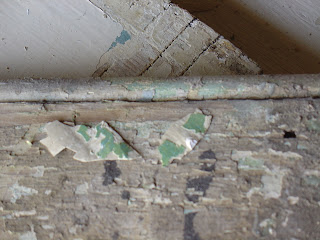Being in this house very long starts to compel one to think about the past, its past, its past lives. And all the lives of people who lived here before.
And inevitably, for someone who is restoration minded, the attempt to keep the house in good repair and livable condition means that as one works on the house, one is constantly trying to understand the history and sequence of previous work on the house.
One of the few places where layers are preserved in sequence is the paint. Trim can be particularly helpful, because it seems that people resist painting trim. Even when they paint or paper walls numerous times, the trim seems to be painted very infrequently. So despite the fact that the house is over 170 years old, it has very few layers of paint on the trim.
Now I need to insert a parenthetical here, because for a number of decades paint had high lead content. Lead is deleterious to health, in particularly insidious and invisible ways. It can cause neurological issues, immune issues, and other health problems. So it is crucial to protect the environment and the rest of the house by containing the area with plastic sheeting whenever work is done on lead paint, and to wear a face-fitting mask with a filter approved for work with lead paint.
That said, I prefer to chip paint carefully with a hammer and chisel or with a very sharp, small scraper. Besides being the easiest way to remove the paint, studies show that this produces the least dust. The other advantage of this method, is that it makes it easy to identify the sequence of paint layers.
The baseboard in the bathroom is original to the house, and it was fairly easy to identify at least five layers on it, three of them various versions of an off-white.
This photo shows the three most obvious off-white layers. At the bottom, a greyish-white very thin almost milk-paint layer. That is the bottom layer of paint, so thin and bonded to the wood, it is virtually impossible to chip off. Next a more gold-colored off-white. And on top, the current layer, a cream color:
Conveniently for this exercise, in between the off-white layers are two layers of colored paint. A beautiful mint green, which is actually the next to the oldest layer of paint, here seen in reverse on the back-side of a couple of chips:
The second most recent layer is an extraordinarily beautiful turquoise, seen here in the center of the piece of trim being worked on.
And here, on the window in the half-bath, at least two of the same top layers, cream and turquoise, which though you can't see here, are also on the medicine cabinet and door trim:
So, from this exercise, we know that the half-bath has been in the house many years, through at least those two layers of paint, and that the tub we just removed was installed after at least three layers of paint, the greyish-white, mint green and an off-white of indeterminate color, had been painted onto the baseboard.
Here is a piece of the baseboard that was behind the tub, and underneath it a piece that was not hidden by the tub. Both have the same mint green paint, but the top piece from behind the tub is clearly lacking the more recent turquoise and cream layers.
The upshot of all this? I've decided not to re-use the baseboard trim in the upstairs bath we're currently renovating. Too much of it has been lost over the years, and we would have to piece it with new, which would be distracting. Also, my little heart can't bear to paint over these beautiful layers of old paint and the incredibly beautiful grain of the old-growth pine, which revealed itself after more chipping and some wet sanding:
So, we bought new trim for the upstairs bath that has virtually the same profile. And, because the half-bath has none of the original baseboard in it, I have saved the old trim to put into the half-bath when we redo that someday. It will match the door, window and cute corner medicine cabinet. What I want to do is encase it in a clear coat, so that these layers will be there for the next owners to see, a visible reminder of all those other hands that have painted this house.






No comments:
Post a Comment